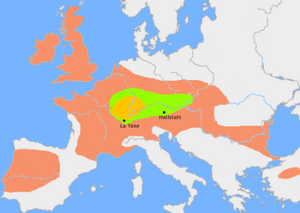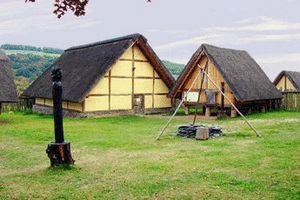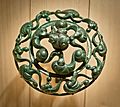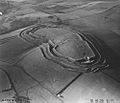La Tène culture facts for kids

The La Tène culture was an important part of the Iron Age in Europe. It existed for about 600 years, from around 500 BC to 100 AD. This culture is named after a town called La Tène in Switzerland, near Neuchâtel.
The La Tène culture was greatly influenced by the powerful Roman and Greek cultures. We know about the La Tène people from two main sources. First, we find many objects they left behind, like tools, weapons, and art. Second, the Romans and Greeks wrote about them. They often called these people Celts. A famous example is Julius Caesar's book, "On the Gallic War" (De bello gallico).
Contents
Who Were the La Tène People?
The people of the La Tène culture were mostly Celts. They lived in groups called clans. These clans were led by important people like druids and bards. Druids were spiritual leaders and judges. Bards were poets and storytellers who kept history alive.
Life for Women in La Tène Culture
Women in the La Tène culture had a better position than women in Roman society. They often had similar rights and status to men. This was different from many other ancient cultures.
Discovering the La Tène Culture
We learn about the La Tène culture through two main ways.
Archaeological Finds
Archaeologists find many things that tell us about their daily lives. These include tools, weapons, jewelry, and pottery. These items show us how they lived, what they ate, and what they believed. The art from this period is very unique. It often features swirling patterns and animal designs.
Ancient Writings
Writings from ancient Romans and Greeks also give us clues. These writings describe the Celts' customs, battles, and way of life. While these accounts are helpful, they are sometimes biased. This is because they were written by people who were often enemies or rivals of the Celts.
Images for kids
-
Overview of the Hallstatt and La Tène cultures. The core Hallstatt territory (800 BC) is shown in solid yellow, the area of influence by 500 BC (HaD) in light yellow. The core territory of the La Tène culture (450 BC) is shown in solid green, the area of La Tène influence by 50 BC in light green. The territories of some major Celtic tribes are labelled. Map drawn after Atlas of the Celtic World, by John Haywood (2001: 30–37).
-
Detail of the Battersea Shield, insular late La Tène style
-
Bibracte oppidum, France, outer walls
-
Oppidum illustration
-
Gergovia fortification wall remains, France
-
Vesontio oppidum, France
-
Maiden Castle hillfort, Britain
See also
 In Spanish: Cultura de La Tène para niños
In Spanish: Cultura de La Tène para niños

































